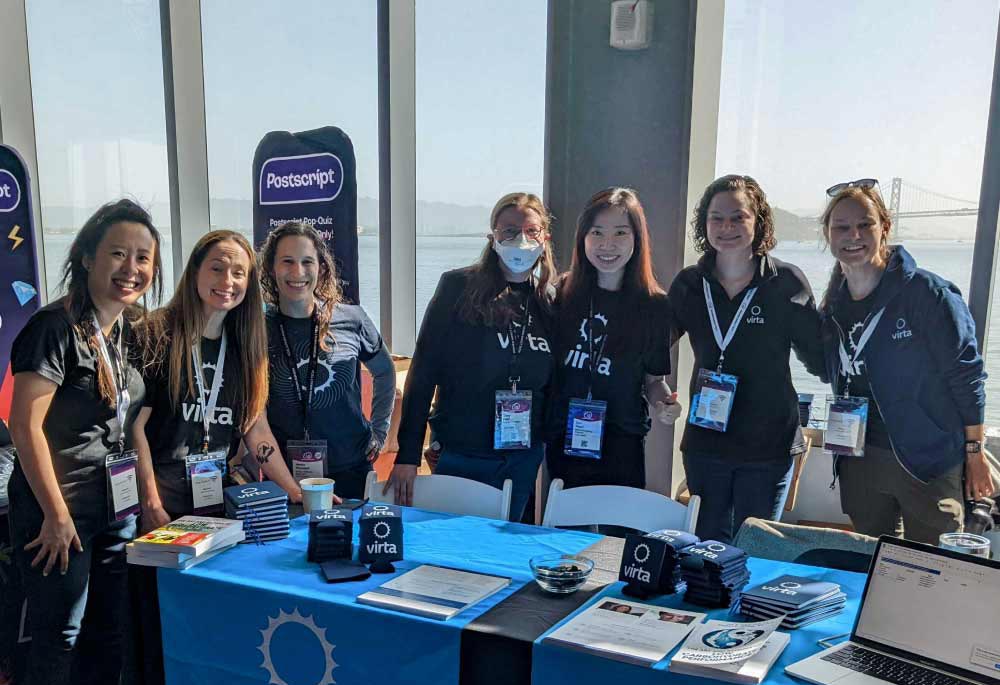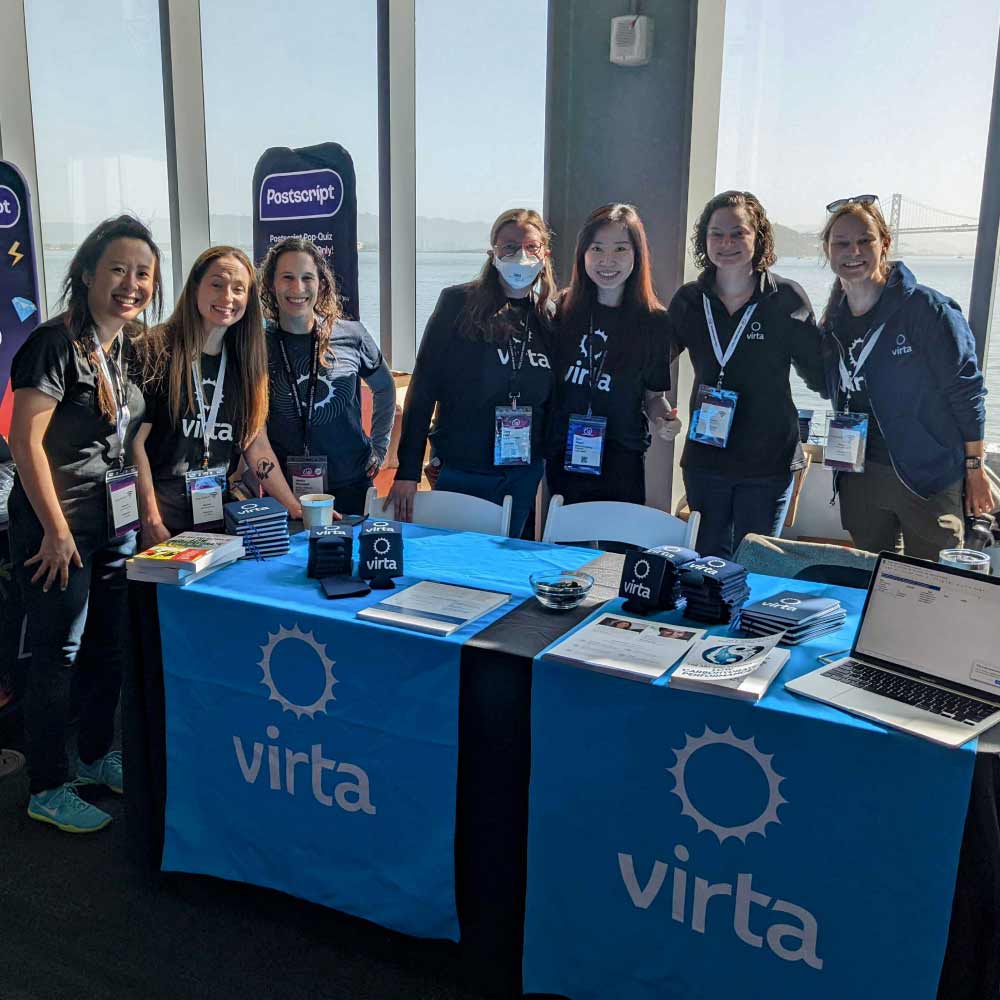
Growing With Virta For 7 Years: From Manager to Head of Engineering

As they say, time flies when you’re having fun. As I approach the 7-year mark at Virta Health, I am genuinely surprised it’s been this long! For the tech world, more than 4 years at the same organization is fairly unusual. In reflecting on the past 7 years, two of which have been during a pandemic, I’m ridiculously proud of where we are today. Not only have we changed tens of thousands of human lives for the better, but we’ve done so with extremely high empathy for our patients and teammates. My journey at Virta has also been life-changing, and my life has changed so much throughout this time. As I’ve advanced from a manager to the Head of Engineering, I’ve gotten married, had my first child, and come back from maternity leave to lead a 60-person team. But let’s start from the beginning.
.jpeg)
I was born in India, and grew up in Mumbai and Pune. I was around computers from a very young age, as my dad was a software engineer. Watching him program and solve problems sparked my initial interest, and I got my undergraduate degree from the Pune University in computer science. Immediately after graduation, I moved to the US to complete my Masters in computer science from the Georgia Institute of Technology. I graduated in 2008, right in the middle of the recession. Funny enough, if not for the recession, I’d probably be working in big tech today. But jobs were sparse at the time, so I joined a 2-person startup that was still in an incubator. I’ve worked in startups ever since.
I’ve always dreamt of using technology to solve problems for the common person. In the era of the early social media boom, my first job was building a civic engagement app. This app connected people to their political representatives and made it easier to identify the specific rep to raise public concerns to. Then, as a pet project to help out a family member, who is a realtor, my now-husband and I worked on an app that allowed folks to search for open houses nearby. While this app never became profitable, it did get me introduced to the founders of Trulia, where I was offered my next job. As one of the early members of the mobile team, I was solving a challenging problem: combining the intricacies of real estate with all the possibilities of mobile technology. Four years later, I was leading the iOS teams for all of Trulia’s applications.
While helping people find their dream home was exciting, I started to crave the opportunity to have more of a social impact. At Trulia, I had worked with Sami Inkinen, who after co-founding Trulia and taking it public, left to start Virta Health—with the bold mission to reverse T2D in 100M people—based on his personal experience with prediabetes. After ruminating on how health-tech really is the need of the hour, I had the opportunity to speak with Sami to learn more about the space. Virta was hiring, and it checked all the boxes for me: it makes patients healthier, it saves astronomical amounts of money in medical costs, AND it would be a learning opportunity. In particular, I wanted to expand my expertise beyond mobile apps and touch all parts of the stack. But as an immigrant on a work visa, this role came with a ton of risk too. I needed a stable employer to be able to stay in the US, and Virta was a pre-series A startup with less than 10 employees. But it was too exciting to pass up, so albeit hesitantly, I took the plunge!
We started off with a small but mighty 100% female engineering team of two and built out the first versions of the applications. The most challenging part of my responsibilities was figuring out the intricacies of following HIPAA while building new technology and making technology choices that would have a long-lasting impact on the company.
.jpeg)
As our Engineering team grew to about 10, we were ready to make our foray into mobile. At Trulia, my expertise for mobile had been built in Objective-C. As we considered which language to choose at Virta just two years later, the landscape for mobile was vastly different. Swift was dominating the market and React Native had entered and began to disrupt the mobile platforms. We decided to go with React Native for three key reasons. First, our frontend was already in React. Second, if we used Swift, we’d have to hire domain-specific expertise for our mobile development team. If we used React Native, our existing frontend developers could work on it. Third, we didn’t need the high performance UI of a video game, and thus React Native made the most sense. With some skepticism but also eagerness to learn a new technology, we started using React Native in 2016 and still use it today. It has worked really well for us, especially because React Native has continued to improve its capabilities, in particular around performance and support for native components. One of the most exciting parts of being in an early-stage startup is getting to take part in major technical decisions, like which programming language to use!
Perhaps the biggest technical challenge I’ve faced at Virta was figuring out how to create a continuous remote care application from scratch. The application needed to allow health coaches and providers to safely treat complex patients remotely and to make medication adjustments in near real-time. When Virta first began taking on patients for our clinical trial, we had a MVP for this application that allowed coaches and providers to communicate with their patients, monitor health status, and safely de-prescribe medications as needed. But as we prepared to scale the Virta treatment to additional populations, we needed to iterate on this MVP to prepare for significant growth. There was no “build versus buy” option, since at the time, no EHRs provided significant functionality for continuous remote care. Furthermore, Virta’s preliminary use case was very specific to reversing type 2 diabetes, and the available remote care tools were fairly generic to chronic disease management and episodic care. We needed a radical departure from traditional telemedicine technology, so we chose to build a scalable continuous remote care application ourselves, which today is called Spark.
To provide continuous care, we need to share a lot of data with our clinicians (coaches and providers) in a timely manner: patient messages, biomarker readings like glucose and ketones, and more. To manage this sharing of data between Spark and our patient app, we had to decide between two major architecture options: batch/async processing and event-driven systems. While we realized that event-driven systems are very scalable and would be the best option in the long-term, we chose to go with batch/async processing for a few reasons. First, event-driven systems would have taken our small team much longer to build than batch/async processing, and as an early-stage startup, speed to delivery was more important than immediate scalability. Second, we were a team of fullstack developers, and while we could build batch/async, we didn’t have the data engineering expertise to build an event-driven architecture. Finally, as a growing startup, we couldn’t spend much of our technical resources on infrastructure improvements. We had critical-path, patient-facing features to deliver that needed to take up most of the roadmap. Spark has scaled with batch/async processing for over 6 years now. Looking back, we made the right decision at the time based on the number of patients and clinicians we needed to support, as well as the lower complexity of our system. As the growth in our patient and thus clinician population accelerates, it’s become time to pay down our tech debt and revisit some of these early architecture decisions. We are currently planning a re-architecture of this system, which is honestly quite exciting for the team! We’re enjoying this opportunity to rethink our technical strategy with more resources and the new technologies available. It’s never boring to work at Virta!
.jpeg)
My career has also grown with the company. As our business, patient population, customers, and teams grew and Virta advanced from Series A to E, I took on increasing levels of leadership: from manager, to senior manager, to director, to my current role as senior director and Head of Engineering. It’s been an amazing journey with many learnings, from developing my leadership style (went from managing 3 engineers to a team of 60 now!), to supporting the team through multiple restructures and leadership changes. My personal life has also grown as fast as Virta in the last 7 years! I got married to my husband in my first year at Virta, which was the most volatile period. We welcomed our first child about a year ago, right in the middle of the pandemic while also tackling a large platform migration at Virta. To say things were chaotic would be an understatement. I am so proud of our culture at Virta which enabled me to take a long paid maternity leave and not worry about a single thing at work.
.jpeg)
So why am I still here? There are three really simple things that have kept me at Virta for this long: impact, people, and challenges. These three things have been consistently rewarding since my first day.
As cliche as it sounds, the impact the Virta treatment has on our patients is extremely fulfilling. When I first joined, one of my greatest motivating factors was to free patients from the burden of the astronomical cost of medications. I initially believed that this would be the largest impact we have on patients. After a few weeks on the job, I realized that while we do save patients (and payers) a lot of money, the impact we have on their quality of life is so much more important. When asked what they love most about Virta, patients tend to give examples about lifestyle changes: being able to ride a bike again, feeling in control of their life, having the energy to play with their grandkids, and not requiring a seat-belt extender anymore. Prior to working at Virta, I had taken all of these things for granted. The fact that we can have such an immense impact on our patients is truly fulfilling and humbling at the same time!
I love the people I work with, and I’ve met some of the most amazing humans at Virta. Everyone seems to live and breathe our mission, which is motivating and inspiring. Virtans truly care about the patients and each other, and demonstrate this through their empathy, investments in our culture, and hard work-ethic to serve our patients. This shows up in many forms: a true willingness to cover for each other when people take time off, the large number of Virtans who participate in randomly assigned buddy-time chats, and celebrating appreciation in company-wide Slack channels like #gratitude. This empathy and sincere interest in others clearly translates into the care we provide our patients, which I believe is a key ingredient in making the Virta treatment so successful. At the end of the day, we all have hard conversations at work sometimes, but at Virta it’s easier knowing that everyone has the patients’ best interests at heart.

My journey has definitely not been without its challenges. But that’s what makes joining a growth startup so much fun! One of our current challenges is scale. Like any worthwhile startup, we spent our initial years proving that our treatment is safe, effective, evidence-based, sustainable, and can be delivered digitally without compromising on safety or outcomes. Now it’s time to scale our treatment to as many patients as possible. Scaling a fullstack healthcare product is a whole different ball-game than scaling a pure technical product. I am enjoying tackling this new obstacle and am certain that we will overcome it, as we have with every obstacle before it.
These nearly 7 years at Virta have been a life-changing experience for me. To see the company grow from a small scrappy team to over 500-strong has been rewarding. I’ve learned and grown so much along the way. After more than 2,500 days on the job, I am more excited than ever to help reverse type 2 diabetes in a 100 million people by 2025! You can join us in this mission—see open roles at https://www.virtahealth.com/careers.
This blog is intended for informational purposes only and is not meant to be a substitute for professional medical advice, diagnosis, or treatment. Always seek the advice of your physician or other qualified health provider with any questions you may have regarding a medical condition or any advice relating to your health. View full disclaimer
Are you living with type 2 diabetes, prediabetes, or unwanted weight?



